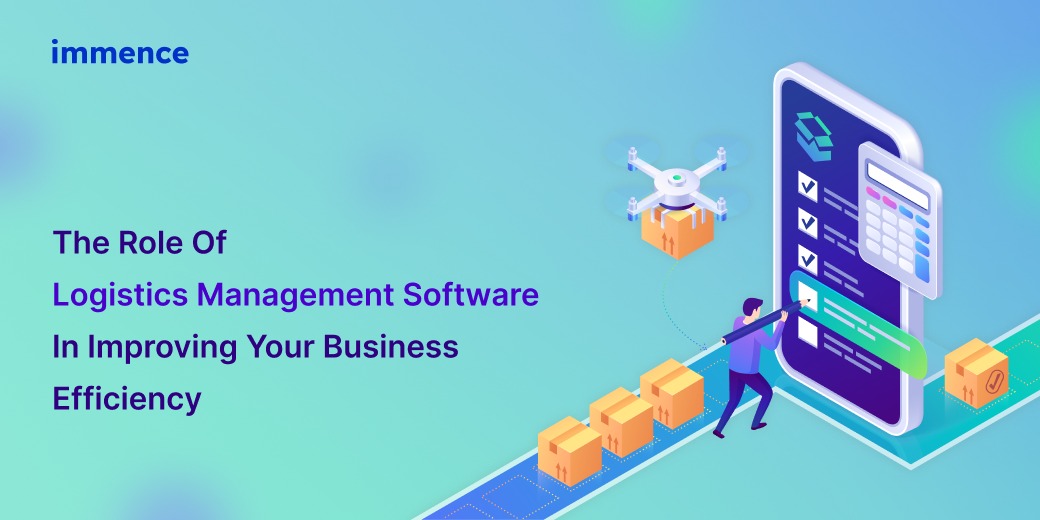The Role Of Logistics Management Software In Improving Your Business Efficiency

Logistics still needs to catch up to operate smoothly, despite being a significant activity for many firms. When updates are delayed, warehousing and transportation frequently remain in conflict, keeping the warehouses either too crowded or completely empty. Digital transformation can play a part in this because it has upended numerous industries and sectors. The answer is a logistics management system!
By automating procedures and utilizing data to guide your decision-making, developing a logistics management system can have a direct influence on your business. Software for logistics management not only reduces costs and streamlines order processing but also gives you better insight into how things are going across the board.
Although the pandemic would contribute to faster adoption of logistics management software, a 35% increase was already seen after 2017. With a CAGR of 8.5%, digital transformation in logistics management is anticipated to reach $23,607 by 2027, up from $11,794.24 in 2019.
You can choose from among the many logistics software providers to have a logistics management system created specifically for your unique business needs.
Have you yet come around to the solution? Join us as we learn more about logistics management software's advantages, features, and processes that would help you out in making the decision for your business.
A logistics management system: What is it?
Every organization relies on logistics, which normally moves forward and backward. Most forms of forward motion include:
- Taking orders and processing them
- Evaluating and creating an inventory
- Selecting, gathering, and sending out the goods
- Selecting a transport route that will deliver the goods to a consumer as soon and efficiently as possible
- Managing returned or damaged shipments, fixing items, and reusing or recycling materials are typical examples of backward or reverse movements.
To organize and automate these processes digitally, businesses use logistics management systems, a collection of software tools that optimize all operations, from placing an order to delivering it to a customer's door.
What are the advantages of a logistics management system?
Any company that wants to succeed in business needs effective management. In addition to offering rapid and secure shipping, warehousing, and delivery services, you can also increase the value of your business. You require a robust software program that will enable you to boost efficiency by streamlining your logistical planning processes, significantly if your organization is growing. Building a logistics management system can be useful in this situation.
- Reducing Operational Costs
The logistics management solutions assist with historical data analysis to provide route optimization that reduces fuel consumption and improves asset utilization while lowering operational costs and increasing company effectiveness.
- Higher Productivity and Delivery Efficiency
The goal of logistics is to boost operational effectiveness without reducing profit margins. Creating a logistics management system may reduce failures, deviations, and faults while also reducing resource waste and meeting quality standards.
- Increased Profitability
Automated logistics management gives businesses a complete understanding of their operations, which enhances customer relationships and reduces the necessity for holding surplus inventory. The company's profitability is subsequently increased due to the improved order fulfillment rate.
- Improved customer satisfaction
For a better customer experience to boost brand loyalty and reputation, businesses implementing a logistics management system may offer improved customer support and a seamless shipping process.
- Improved Intermodal Operations
Freight is transferred using two or more different modes of transportation during intermodal operations to get it from the source to the client. In order to reduce the risks involved with intermodal operations, minimize costs, and improve the dependability, safety, and environmental friendliness of transportation, standardized containers are used in a logistics management system.
- Detailed Route Planning
Utilizing a clever route planning tool, logistics management software development enables businesses to select the best shipping routes for their goods in order to save empty miles, avoid traffic congestion, and guarantee on-time delivery to clients.
Features of Logistics Management Software
List the essential components you want a logistics management system to include in order for it to meet your needs. A few key LMS characteristics are listed below.
- Multi-client architecture: This would allow businesses to manage a number of clients during various logistics activity phases while utilizing the same data and database.
- Better demand prediction: Businesses will be able to plan resources without running out of supply if demand and price forecasts are more accurate. This will help reduce inventory.
- Finance Integration: This role will support efficient transaction and accounting management.
- Simple warehouse management: This feature will help make it easier to control the movement and storage of the goods that drivers deliver to clients on time.
- Processing orders and billing: With the aid of this feature, businesses are able to create orders and send bills to clients online.
- Production of freight bills: Businesses can generate bills of freight using the LMS, which will speed up the process of transactions involving the transportation of products between the shipper and the logistics firm consignee.
- Transportation management: This function assists in determining more efficient delivery routes for better coordination of shipment transportation.
What Other Features Must Be Integrated to Take Advantage of an LMS?
The task of managing logistics operations is difficult and necessitates the use of all technologies. The most well-known ones are listed below.
- Cloud storage: Following deliveries throughout various supply chain sectors is simpler and more comfortable. Furthermore, cloud-based logistical systems can remind you to accomplish necessary tasks and securely save your data.
- APIs: The transport hub is a part of the globe that has gone digital. Massive amounts of incoming data must be collected and managed well. The APIs are the greatest instruments for handling it. In this way, shipping APIs can be your trustworthy partners in keeping track of the delivery date precisely and avoiding supply chain issues.
- Payment gateways: With the help of such integration, your consumers will be able to pay for your services online. PayPal or Stripe can assist with your payment-related worries. However, bear in mind that every project is unique. Therefore, when integrating a payment gateway, you might need the help and guidance of an experienced IT company. With the aid of the technology company you have collaborated with, you can also choose to develop your own payment gateway.
- Third-Party Logistics: With the help of third-party logistics (3PL), you may outsource functional logistics from the warehouse to delivery, saving yourself some time so that you can concentrate on other organizational difficulties.
5 Main Steps to Develop Logistics Management Software
If you have made the decision to create logistics management software from scratch, you must be familiar with the step-by-step process.
Step 1: Selecting a Software Development Services Provider
It's crucial to choose the best logistics software development company if you want to create logistic management software that successfully carries out your business goals. Pay great attention to the qualifications and areas of experience of your potential technical partner. They must be familiar with the most recent trends, technology, and functionality in logistics management solutions.
Step 2: The Research Stage
Spend some time discussing your needs and expectations with the development team after deciding on the service. You can use them to help you make decisions on project functionality, time, and cost estimates for the necessary solution and the definition of the project's goals.
Step 3: The Software Development Process
The decision of whether your solution will be cloud-based or on-premises is the first stage in the entire process. Will a mobile version of your program be necessary as well? Keep in touch with your development team throughout this time and attend all your scheduled online meetings to stay on the same page and track progress.
Step 4: Inspection of quality
Inspection for quality should be a part of the development process, where QA experts will assess the effectiveness and functioning of the product. You can take part in the second stage of software testing as a product owner to evaluate the robustness and general caliber of your logistics management solution.
Step 5: Launching and Scaling Up the Product
It's time to instruct your workers on how to use the software you created for logistics management. Your staff can now provide incisive comments on the product. You can go back to the developers and ask them to upgrade your solution or add new functions that have become necessary when you decide it's time to scale up or adjust your operations.
What's Next?
Choosing a logistics solution is the first step towards streamlining the complete cycle of supply chain and logistical operations. A customized logistics management solution that can satisfy the needs of each provider is necessary for the efficient management of every phase, from procurement to delivery. For instance, a company requires a tool for its internal logistics department to optimize its current process.
By working with a software development vendor, businesses may implement logistics management software that is specifically designed to meet their needs. The advantage of custom logistic solutions can help businesses, from wholesalers to distributors to e-commerce, according to pioneers in custom software development like Immence. To quickly and effectively lead your operations, get in touch with us.
Shreya Viradiya
Business Development Executive


